Meet the updated Windows Azure. A small review of innovations
Good afternoon, dear colleagues. Tired of the lack of sleep of the last days (morning Venus, MEET Windows Azure) are sleeping, a humble author sits in Tomsk and writes these lines, experiencing something like extravaganza from what is happening in the IT world now. And we, friends, are on the verge of the ultimate need to change the paradigm.
In this article, I will try to convey in a short review what happened last night at the MEET Windows Azure event - a major release of new platform functionality. The main report was made by a bright mind, which on Twitter was called "Midas of Our Modernity" - Scott Guthrie.
So, to be brief, the list of innovations and changes recorded by me looks like this.
Let's take a closer look at what the guys at Microsoft suggested to us.
New administration portal The
new portal, written in HTML5, works quickly and naturally, supporting filtering and sorting (which simplifies the use of the portal for large deployments), works in all browsers and provides a large number of new features, including integrated monitoring functionality for VMs, Web sites , storage and cloud services. The new portal was developed in Windows Azure based on the REST management API. Everything that can be done on the portal can also be done in program code using this Web API.

As written on Twitter, the new portal works great on Mac, iPad and WP. Previously, you had to work hard for this, given the Silverlight on which the portal was written.
Command Line Utilities Command line
utilities (using the REST management API) have become available that make scripting and automation of administration tasks even easier. Utilities are available for both Windows (Powershell) and Mac and Linux (Bash). The program codes of these utilities, as well as the program codes of other Microsoft SDKs, are available on GitHub under the Apache 2 license.
IAAS (Infrastructure as a service)
Windows Azure now supports the ability to deploy and run durable virtual machines in the cloud. You can create these virtual machines using the gallery of templates that is transparently integrated into the portal or create, download and launch your own VHD image. In the image gallery, the images of the following operating systems are available:
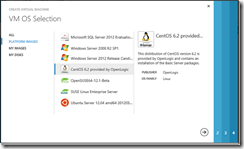
Virtual machines are durable (which means that everything that is installed on them will be saved after a reboot) and can store any operating system. Our integrated image collection includes both a Windows Server image (including the recently introduced Windows Server 2012 RC) and Linux (Ubuntu, CentOS, SUSE). After creating a VM instance, you can easily connect to it using a terminal server or SSH, and configure the virtual machine as you need (and, if necessary, remove the snapshot of the image to create new instances of the virtual machine). All this provides the flexibility to run most types of tasks in Windows Azure. Thanks to the familiar open VHD format, virtual machines can easily migrate from their existing on-premises infrastructure to the cloud (and vice versa).
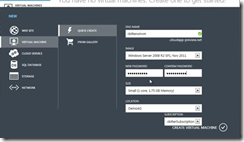
The new Windows Azure Administration Portal contains a wide range of capabilities for administering virtual machines, including monitoring and tracking resource consumption within virtual machines. Long-term storage in virtual machines is replicated in triplicate, and two backups are always available, which will be used in case of failure, for example, of a disk. Support for virtual machines also means simply connecting multiple data disks to virtual machines (which can be mounted and formatted as disks). You can also enable geo-replication for virtual machines, which will cause the platform to constantly replicate your storage to another data center located at least 400 miles from the original data center to provide redundancy.
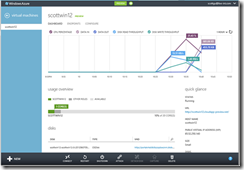
Access to virtual machines can be done from the Windows Azure management portal or using Powershell (with the new June Windows Azure SDK).
How is all this good? Previously, the VM role was in an “evolving feature” state and only supported Windows 2008 R2 SP1. The developer needed to prepare an image and upload it to VHD, which took (considering the size of the VHD) the clock. Microsoft's new offering uses preconfigured operating system images that are ready to use right after creation.
To start using the virtual machine service, you need to request access to the Preview version (however now access is very limited and, as I understand it, the Preview versions are available only to people close to the body - MVP, Windows Azure Insiders, etc. I may be mistaken). In any case, in the account menu you need to click on 'Preview Features'. SLA, by the way, is not applied to the Preview function. An interesting document.
Web sites
New functionality that will allow Microsoft cloud platform to be more seriously competed with familiar to all hosters with a hosting offer for $ 5. Web sites can be developed on ASP.NET, Node.js or PHP (or CMS - WebMatrix, Joomla, Drupal, WordPress, DotNetNuke, Umbraco, etc.) and deploy in seconds using FTP, Git or TFS. At the same time, primary use is free, then the websites are scaled vertically according to the increase in traffic. The demo showed how to quickly create a website in Visual Studio using .NET (ASP.NET MVC 4). All this works both in VS 2010 and in VS 2012, and it works very quickly.
In the case of Mac and Node.js, instead of the administration portal, you will need to use the command line and Git.
By default, websites are in the Shared Website state, that is, the power is shared between websites, but if necessary, you can increase the number of instances and put the website in the Reserved state.
Available is MySQL, which is provided as a service (ClearDB) and integration with Microsoft WebMatrix. And the best part is that you can have up to 10 websites for free . Of course, this is not without pitfalls - for the same SQL Server and traffic you still have to pay. But the proposal itself (and, in general, not so high prices for traffic and transactions) allows you to do what was almost inaccessible before - to place small, if not personal, projects in Windows Azure.
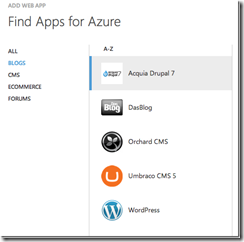
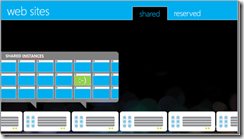
As for scaling and load balancing - everything is done by Windows Azure. You can start small and switch to a large project without any problems. There are three scaling options available - increasing the processes for the site, transferring the website to the virtual machine and adding virtual machines and controlling the capacity of the virtual machine (switching from a 1.0GHz single-core instance to an extra large 8-core instance with 14 GB RAM on board).
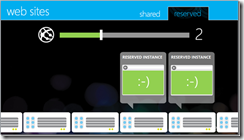
According to simple analyzes already done, some started comparing Microsoft's web hosting and offering. According to one of the bloggers, the offer of the company that he uses as a hoster for 10 sites with excellent technical support is only 1/3 cheaper. This is an excellent ratio, it seems to me, and given the possibility of transparent scaling and load balancing, we can consider the offer of Windows Azure to a large extent competitive.
People immediately had a question - what to use, websites or cloud services? In principle, you can answer quite simply - if there is no special need for control over the virtual machine and it does not matter to you that the resources will be distributed among users by default, then use the websites. If you need control over your environment, please, Cloud Services with the usual model of Web / Worker roles is still here.
You are also asked questions about configuring your own SSL certificates for websites. Judging by the flashed answer during the broadcast, it’s not yet possible to do this, but very soon the opportunity will appear.
Cloud services
I must say that for me personally such a powerful rebranding looks like the right decision - to be honest, I did not like the name Hosted Services, and the rest of the names. Everything is clear and understandable right there.
As I understand it, conceptually Cloud Services remained the same Hosted Services - a multilayer application is being developed based on a website and adding a Worker role, a service package is being downloaded on the portal (and now the super-news is in a ZIP format!), After which Fabric Controller it searches for capacities, raises virtual machines on them and loads your application on these virtual machines and configures load balancers and DNS.
Building blocks
Additional services that make the developer’s life easier. Given the new services (Hadoop, Media Services, etc), the updated set of additional services includes (I think it’s unnecessary to explain what was what):
big data
database:
storage:
traffic:
caching:
messaging:
identity:
media:
CDN
networking:
integration with Marketplace
Additional services can be used by both .NET-based applications and Node.js, Java, PHP, Python - all libraries are published on GitHub under the Apache2 license and provide a very pleasant API to use.
New SDKs
New versions of the SDK are now available.
The Windows Azure SDK .NET adds support IISExpress and LocalDB in the emulator and the ability to preview using a dedicated caching with support for Visual Studio at level. Added support for Service Bus in Visual Studio and updated other client libraries. If you look closely at the changes, you will notice that in Visual Studio the project is now called the Windows Azure Cloud Service. From specific innovations:
1) The appropriate assemblies and NuGet packages are added to Azure projects: for example, CloudConfigurationManager, with which you can easily access configuration settings using a smart algorithm that first checks the cloud configuration file (.cscfg), and then goes to web / app .config if configuration is not available. 2) New templates. New templates include MVC4 / MVC4 Web API, Worker roles with Service Bus, Worker roles with Cache. 3) For advanced development scenarios, a mechanism was added to include user files and folders in the installation when deploying a role - for this, click Add -> Item ... or Add -> Folder on a cloud project.

Visual Studio also added features for convenient caching management. Now, in order to add caching support to the application, you need to open the role in the designer and select the Enable Caching option in the Caching tab, then determine the cache size using the slider and make other settings. You can use the Windows Azure Caching Preview NuGet package, which, during installation, performs the necessary caching settings in the web / app.config files. Learn more about caching . You can install all this joy both manually and using the Web Platform Installer. For SDK Java client library for the use of tables of service added. For SDK Node.js
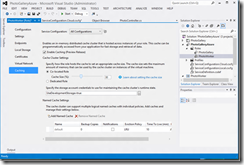
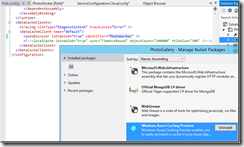
Service Runtime client libraries added.
For SDK PHP added client libraries for storage services, Service Bus and Service Runtime and Windows Azure PowerShell cmdlets.
For SDK Python added PowerShell cmdlets and client libraries (Windows, Linux, Mac), Django support, Windows Azure and Django in PTVS ( http://pytools.codeplex.com ) and IPython (from Windows clients, Linux and Mac) to virtual machines (Linux or Windows).
Pricing Updates
· Cloud9 At Node Summit, Microsoft announced support for deployment to Windows Azure. Today, it was announced that Cloud9 has full support for Windows Azure Websites - now in Cloud9 you can create websites and quickly deploy them using Git. The news . Node.js developers, check out the screenshots below. The most famous in his circles Glenn Block says that you only need to deploy your application. The system will take package.json and upload all the necessary NPM modules to the server. Team Foundation Service and we at Windows Azure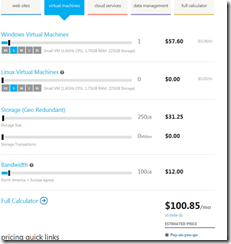
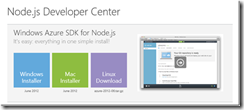

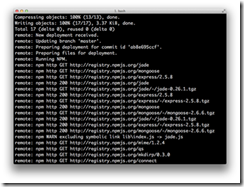
After creating a website, when you go to its control panel, the Setup TFS Publishing option is available (in the lower right corner). Clicking starts the setup of connecting the TFS project to the application in Azure. In the process of setting up, we are asked to indicate an existing Team Foundation Service account or create a new one, and then select Team Project, which will host the application sources. After that, the Windows Azure and Team Foundation Service accounts will be linked. Now you can create and deploy an application from Visual Studio by connecting to your TFS account. Deployment results can be viewed in the TFS report, on the Azure windows portal, or in the TFS web interface.
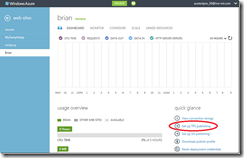
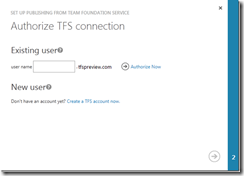
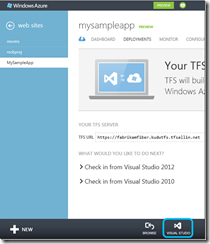
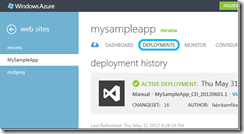
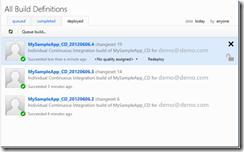
In fact, there is not much magic - OAuth is used to link TFS and Azure, which is now closed, but they are going to open it in the future.
Instructions for setting up a local TFS Build for deployment on Windows Azure .
Summary:
What happened yesterday should change the situation of a small stagnation in cloud computing (more precisely, not stagnation, but too smooth development). Microsoft rolled out so much in one day that foreign experts have already recognized that if everything goes well, the corporation will not only get out on par with Amazon, but will also become a leader in the industry.
Prior to this, I published a comparison of the storage services of Windows Azure and Amazon - as you can see, some of the “holes” were successfully closed. In addition, Amazon was a cut above Windows Azure in the context of IaaS, but now it turned out that Windows Azure immediately grew one and a half heads. I really hope that everything that happened will lead to the rapid development of all cloud platforms and a bright future.
Thanks for attention. Next, I will try to reveal the use of innovations in Windows Azure in more detail.
Most of the images were stolen from Scott Guthrie, Scott Hanselman and others. I hope no one will be offended. :)
Some links
In this article, I will try to convey in a short review what happened last night at the MEET Windows Azure event - a major release of new platform functionality. The main report was made by a bright mind, which on Twitter was called "Midas of Our Modernity" - Scott Guthrie.
So, to be brief, the list of innovations and changes recorded by me looks like this.
- A completely new portal, which is in the Preview stage (attentive ones have already noticed that the new portal does not yet have the ability to administer additional services such as ACS and SB - this will be later, while you need to use the old one).
- Command line utilities.
- IAAS
- Web sites
- Cloud Services - Formerly Hosted Services.
- Building Blocks - rebranding and new services.
- New SDKs.
- Pleasant updates in pricing.
- Cloud9 Support
- Monitoring and statistics of everything and everything.
- Team Foundation Service and Windows Azure.
- Official availability of Windows Azure in 89 countries (including Russia!)
Let's take a closer look at what the guys at Microsoft suggested to us.
New administration portal The
new portal, written in HTML5, works quickly and naturally, supporting filtering and sorting (which simplifies the use of the portal for large deployments), works in all browsers and provides a large number of new features, including integrated monitoring functionality for VMs, Web sites , storage and cloud services. The new portal was developed in Windows Azure based on the REST management API. Everything that can be done on the portal can also be done in program code using this Web API.

As written on Twitter, the new portal works great on Mac, iPad and WP. Previously, you had to work hard for this, given the Silverlight on which the portal was written.
Command Line Utilities Command line
utilities (using the REST management API) have become available that make scripting and automation of administration tasks even easier. Utilities are available for both Windows (Powershell) and Mac and Linux (Bash). The program codes of these utilities, as well as the program codes of other Microsoft SDKs, are available on GitHub under the Apache 2 license.
IAAS (Infrastructure as a service)
Windows Azure now supports the ability to deploy and run durable virtual machines in the cloud. You can create these virtual machines using the gallery of templates that is transparently integrated into the portal or create, download and launch your own VHD image. In the image gallery, the images of the following operating systems are available:

- Windows server
- Windows Server 2008 R2
- Windows Server 2008 R2 with SQL Server 2012 Eval
- Windows Server 2012 RC
- Linux:
- OpenSUSE 12.1
- CentOS 6.2
- Ubuntu 12.04
- SUSE Linux Enterprise Server 11 SP2
Virtual machines are durable (which means that everything that is installed on them will be saved after a reboot) and can store any operating system. Our integrated image collection includes both a Windows Server image (including the recently introduced Windows Server 2012 RC) and Linux (Ubuntu, CentOS, SUSE). After creating a VM instance, you can easily connect to it using a terminal server or SSH, and configure the virtual machine as you need (and, if necessary, remove the snapshot of the image to create new instances of the virtual machine). All this provides the flexibility to run most types of tasks in Windows Azure. Thanks to the familiar open VHD format, virtual machines can easily migrate from their existing on-premises infrastructure to the cloud (and vice versa).

The new Windows Azure Administration Portal contains a wide range of capabilities for administering virtual machines, including monitoring and tracking resource consumption within virtual machines. Long-term storage in virtual machines is replicated in triplicate, and two backups are always available, which will be used in case of failure, for example, of a disk. Support for virtual machines also means simply connecting multiple data disks to virtual machines (which can be mounted and formatted as disks). You can also enable geo-replication for virtual machines, which will cause the platform to constantly replicate your storage to another data center located at least 400 miles from the original data center to provide redundancy.

Access to virtual machines can be done from the Windows Azure management portal or using Powershell (with the new June Windows Azure SDK).
How is all this good? Previously, the VM role was in an “evolving feature” state and only supported Windows 2008 R2 SP1. The developer needed to prepare an image and upload it to VHD, which took (considering the size of the VHD) the clock. Microsoft's new offering uses preconfigured operating system images that are ready to use right after creation.
To start using the virtual machine service, you need to request access to the Preview version (however now access is very limited and, as I understand it, the Preview versions are available only to people close to the body - MVP, Windows Azure Insiders, etc. I may be mistaken). In any case, in the account menu you need to click on 'Preview Features'. SLA, by the way, is not applied to the Preview function. An interesting document.
Web sites
New functionality that will allow Microsoft cloud platform to be more seriously competed with familiar to all hosters with a hosting offer for $ 5. Web sites can be developed on ASP.NET, Node.js or PHP (or CMS - WebMatrix, Joomla, Drupal, WordPress, DotNetNuke, Umbraco, etc.) and deploy in seconds using FTP, Git or TFS. At the same time, primary use is free, then the websites are scaled vertically according to the increase in traffic. The demo showed how to quickly create a website in Visual Studio using .NET (ASP.NET MVC 4). All this works both in VS 2010 and in VS 2012, and it works very quickly.
In the case of Mac and Node.js, instead of the administration portal, you will need to use the command line and Git.
By default, websites are in the Shared Website state, that is, the power is shared between websites, but if necessary, you can increase the number of instances and put the website in the Reserved state.
Available is MySQL, which is provided as a service (ClearDB) and integration with Microsoft WebMatrix. And the best part is that you can have up to 10 websites for free . Of course, this is not without pitfalls - for the same SQL Server and traffic you still have to pay. But the proposal itself (and, in general, not so high prices for traffic and transactions) allows you to do what was almost inaccessible before - to place small, if not personal, projects in Windows Azure.


As for scaling and load balancing - everything is done by Windows Azure. You can start small and switch to a large project without any problems. There are three scaling options available - increasing the processes for the site, transferring the website to the virtual machine and adding virtual machines and controlling the capacity of the virtual machine (switching from a 1.0GHz single-core instance to an extra large 8-core instance with 14 GB RAM on board).

According to simple analyzes already done, some started comparing Microsoft's web hosting and offering. According to one of the bloggers, the offer of the company that he uses as a hoster for 10 sites with excellent technical support is only 1/3 cheaper. This is an excellent ratio, it seems to me, and given the possibility of transparent scaling and load balancing, we can consider the offer of Windows Azure to a large extent competitive.
People immediately had a question - what to use, websites or cloud services? In principle, you can answer quite simply - if there is no special need for control over the virtual machine and it does not matter to you that the resources will be distributed among users by default, then use the websites. If you need control over your environment, please, Cloud Services with the usual model of Web / Worker roles is still here.
You are also asked questions about configuring your own SSL certificates for websites. Judging by the flashed answer during the broadcast, it’s not yet possible to do this, but very soon the opportunity will appear.
Cloud services
I must say that for me personally such a powerful rebranding looks like the right decision - to be honest, I did not like the name Hosted Services, and the rest of the names. Everything is clear and understandable right there.
As I understand it, conceptually Cloud Services remained the same Hosted Services - a multilayer application is being developed based on a website and adding a Worker role, a service package is being downloaded on the portal (and now the super-news is in a ZIP format!), After which Fabric Controller it searches for capacities, raises virtual machines on them and loads your application on these virtual machines and configures load balancers and DNS.
Building blocks
Additional services that make the developer’s life easier. Given the new services (Hadoop, Media Services, etc), the updated set of additional services includes (I think it’s unnecessary to explain what was what):
big data
database:
- relational database service
- clustering
- SQL Reporting Now SQL Reporting as a whole is available, and even with SLA. SQL Reporting allows you to publish reports to the cloud or embed reports directly into local applications that can be used using a browser, mobile device or PC. Read more here .
storage:
- excessive local storage ( Locally Redundant the Storage) for those who do not need the geo-replication and should be reduction in data storage costs
- blob leasing
- copy blob between storage accounts
- Shared Access Signature (SAS) for tables and queues (this is really a great idea!)
- more details
traffic:
- as I understand it, the former Traffic Manager, which allows you to route traffic as convenient for the client
caching:
- Memcached protocol support
- distributed service or use at the application level (local caching)
- the possibility of a dedicated caching layer created for one or more applications from a variety of Worker roles, providing almost unlimited amounts of caching and scaling
- notifications
- tags
- the regions
- high availability
- more details
messaging:
- secure communications and relays
- the foundation of hybrid applications and loosely coupled solutions
- cross platform SDK
identity:
- Active Directory integration with multiple identity providers
- SSO
- Enterprise Graph REST API
- given that 93% of Fortune 1000 use Active Directory, this is helpful :)
- from a rapidly disappearing list of questions in the broadcast, I managed to see that the Identity service will soon support the JWT token format (Wow!)
media:
- creation, management and distribution of multimedia content
- wide range of formats and devices
- Ingest, Encode, Protect, Stream!
CDN
networking:
- Virtual Private Networking (VPN) instances in Windows Azure and local machines
- control over network topology - you can specify ranges of IP addresses or DNS server
- IPSEC
- Using VPN devices from vendors, such as Cisco
integration with Marketplace
Additional services can be used by both .NET-based applications and Node.js, Java, PHP, Python - all libraries are published on GitHub under the Apache2 license and provide a very pleasant API to use.
New SDKs
New versions of the SDK are now available.
The Windows Azure SDK .NET adds support IISExpress and LocalDB in the emulator and the ability to preview using a dedicated caching with support for Visual Studio at level. Added support for Service Bus in Visual Studio and updated other client libraries. If you look closely at the changes, you will notice that in Visual Studio the project is now called the Windows Azure Cloud Service. From specific innovations:
1) The appropriate assemblies and NuGet packages are added to Azure projects: for example, CloudConfigurationManager, with which you can easily access configuration settings using a smart algorithm that first checks the cloud configuration file (.cscfg), and then goes to web / app .config if configuration is not available. 2) New templates. New templates include MVC4 / MVC4 Web API, Worker roles with Service Bus, Worker roles with Cache. 3) For advanced development scenarios, a mechanism was added to include user files and folders in the installation when deploying a role - for this, click Add -> Item ... or Add -> Folder on a cloud project.
Visual Studio also added features for convenient caching management. Now, in order to add caching support to the application, you need to open the role in the designer and select the Enable Caching option in the Caching tab, then determine the cache size using the slider and make other settings. You can use the Windows Azure Caching Preview NuGet package, which, during installation, performs the necessary caching settings in the web / app.config files. Learn more about caching . You can install all this joy both manually and using the Web Platform Installer. For SDK Java client library for the use of tables of service added. For SDK Node.js


Service Runtime client libraries added.
For SDK PHP added client libraries for storage services, Service Bus and Service Runtime and Windows Azure PowerShell cmdlets.
For SDK Python added PowerShell cmdlets and client libraries (Windows, Linux, Mac), Django support, Windows Azure and Django in PTVS ( http://pytools.codeplex.com ) and IPython (from Windows clients, Linux and Mac) to virtual machines (Linux or Windows).
Pricing Updates
- Prices for Preview virtual machines . During the preview period, virtual machines with Windows Server and Linux will be paid based on the cost of .013 for xSmall, .08 for Small, .16 for Medium, .32 for Large, and .64 for XLarge per hour.
- Pricing for Preview SQL Server Virtual Machines. During the preview period, SQL Server 2012 Eval Edition will be free, after which, in GA, the SQL Server 2012 Web image and Standard Edition will be paid extra.
- Prices for storage, CDN and network traffic. Customers using these services will automatically see a decrease in cost with increasing use. You don’t need to do anything extra - if the client is Pay As You Go, he will automatically receive this advantage.
- Locally Redundant Storage . Local redundant storage will have a 33% discount compared to geo-redundant storage.
- Reduce transaction costs . Vault and CDN transaction cost reduced by 90% !!! (c .01 for 10,000 transactions to .01 for 100,000 transactions). Announcement of the development team .
- More on pricing
· Cloud9 At Node Summit, Microsoft announced support for deployment to Windows Azure. Today, it was announced that Cloud9 has full support for Windows Azure Websites - now in Cloud9 you can create websites and quickly deploy them using Git. The news . Node.js developers, check out the screenshots below. The most famous in his circles Glenn Block says that you only need to deploy your application. The system will take package.json and upload all the necessary NPM modules to the server. Team Foundation Service and we at Windows Azure




After creating a website, when you go to its control panel, the Setup TFS Publishing option is available (in the lower right corner). Clicking starts the setup of connecting the TFS project to the application in Azure. In the process of setting up, we are asked to indicate an existing Team Foundation Service account or create a new one, and then select Team Project, which will host the application sources. After that, the Windows Azure and Team Foundation Service accounts will be linked. Now you can create and deploy an application from Visual Studio by connecting to your TFS account. Deployment results can be viewed in the TFS report, on the Azure windows portal, or in the TFS web interface.





In fact, there is not much magic - OAuth is used to link TFS and Azure, which is now closed, but they are going to open it in the future.
Instructions for setting up a local TFS Build for deployment on Windows Azure .
Summary:
What happened yesterday should change the situation of a small stagnation in cloud computing (more precisely, not stagnation, but too smooth development). Microsoft rolled out so much in one day that foreign experts have already recognized that if everything goes well, the corporation will not only get out on par with Amazon, but will also become a leader in the industry.
Prior to this, I published a comparison of the storage services of Windows Azure and Amazon - as you can see, some of the “holes” were successfully closed. In addition, Amazon was a cut above Windows Azure in the context of IaaS, but now it turned out that Windows Azure immediately grew one and a half heads. I really hope that everything that happened will lead to the rapid development of all cloud platforms and a bright future.
Thanks for attention. Next, I will try to reveal the use of innovations in Windows Azure in more detail.
Most of the images were stolen from Scott Guthrie, Scott Hanselman and others. I hope no one will be offended. :)
Some links
- Windows Azure SDK: https://www.windowsazure.com/en-us/develop/overview/
- Windows Azure Portal: http://windows.azure.com
- How to work with websites, virtual machines, etc.: http://www.meetwindowsazure.com/DigitalChalkTalks
